
Everyone can experience emotional damage, but not all know when or how to voice it in a legal way. The rise of suing for emotional distress has opened doors for many to address their silent sufferings. But when does emotional turmoil warrant an emotional distress lawsuit? Dive into this guide to unravel when and how the law stands by those grappling with unseen scars.
Emotional distress, a term close to mental anguish meaning, is the mental pain one feels due to someone else’s actions. But, how does the law see this? Let’s take a closer look at the legal nuances of these terms.
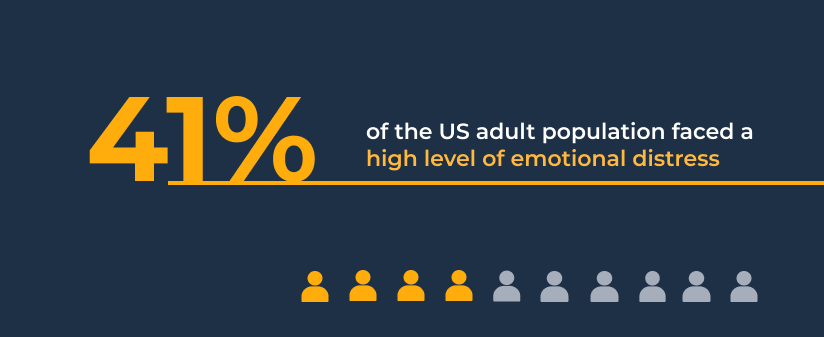
A staggering 41% of US adults have grappled with high levels of psychological distress. Yet, not every instance provides reasons to sue for emotional distress in the legal arena.
Emotional distress is the psychological toll one bears due to certain events or actions, leading to feelings like anxiety, shame, or insomnia. It’s not just about hurt feelings; it’s about genuine mental repercussions often ignited by others.
In the courtroom, this distress is tangible harm, giving grounds for a lawsuit.
Recognizing emotional suffering is the first step to realizing the gravity of emotional distress cases won in courts. Common signs include:
Those grappling with such emotional distress examples have a legal avenue, potentially suing for emotional abuse or mental distress.

Check out our article “How Many Female Lawyers in the US? Statistics Overview“
When it comes to suing for emotional damages, the law differentiates between intentional and negligent infliction.
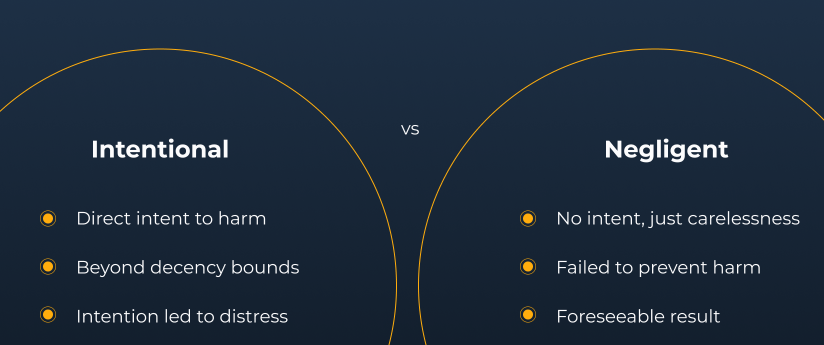
Intentional Infliction of Emotional Distress (IIED) is a legal term for when someone’s actions, far more severe than mere rudeness, intentionally wreak emotional havoc on another.
Here’s what you need to know for an IIED claim:
For example, if someone blackmails you for a long time, causing moral harm, this is an IIED case.
Remember, there’s a ticking clock on IIED claims. The intentional infliction of emotional distress statute of limitations is 2 years. Don’t let time run out on seeking justice.
Negligent Infliction of Emotional Distress (NIED) is a legal avenue for those who’ve suffered emotional turmoil due to another’s careless actions. It’s not about intentional harm but rather negligence that leads to emotional distress.
Here’s a breakdown of an NIED claim:
It’s about holding individuals accountable for the emotional aftermath of their careless actions.
Case “Bullying at school”
For example, how to sue a school for emotional distress? If a campus overlooked instances of bullying, leading to emotional turmoil, the student might consider suing the college for emotional distress.
This case aligns with NIED criteria. The school owed the student a duty of care and failed to uphold it, leading to emotional distress. Engaging with classmates, potential witnesses, and the school psychologist can strengthen your position in this matter.
Case “Witnessing a relative’s injury”
Another case is when a family stands on the sidewalk, and the DUI or OVI driver veers onto it, resulting in the involuntary manslaughter or mutilation of a family member. A relative who witnesses this tragic event may experience profound emotional trauma. This witness could sue the driver for emotional distress due to the traumatic incident they observed.
Case “Loss of social security support”
And finally, can you sue social security for emotional distress as an NIED case? Yes, consider a person dependent on Social Security benefits who stops receiving them due to an administrative error. This abrupt loss of support can cause severe stress and anxiety, especially if they have no other means.
If they can prove their emotional distress resulted from the Social Security Administration’s negligence, they may have a valid NIED case. The administration, responsible for timely benefit distribution, failed in its duty by stopping benefits. The individual’s significant emotional distress was a foreseeable outcome of this negligence.
One of the most challenging aspects of an emotional distress lawsuit is the burden of proof. How do you prove emotional distress, especially when the scars are internal? Let’s figure it out.
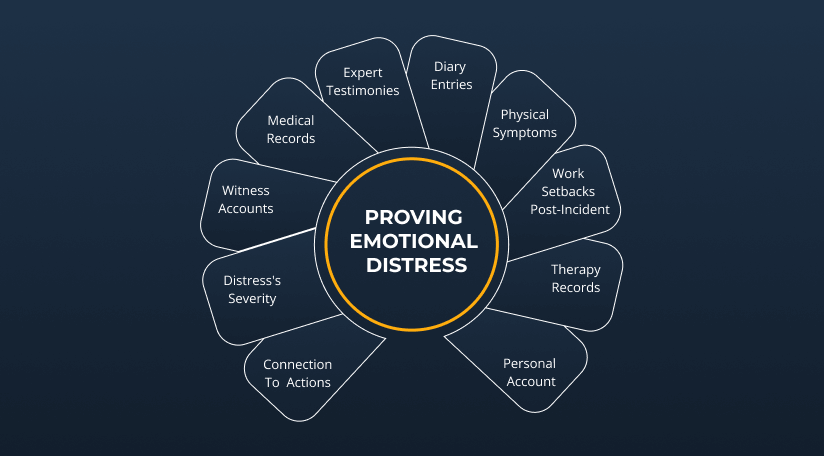
Here’s how to prove emotional distress in court:
Keep in mind, the accused will mount a strong defense. Tread carefully, as false claims of suing for emotional distress could backfire with penalties.
Let’s look at whether can you sue someone for emotional distress and unravel the journey from start to finish.
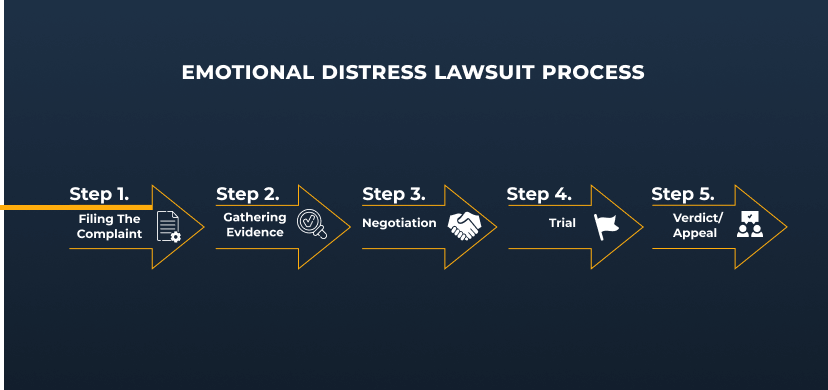
Here’s a streamlined guide to help you understand the civil lawsuit for emotional distress process:
Remember, suing for pain and suffering emotional distress can be a challenging process, but with the right emotional distress attorney, you can seek the compensation you deserve.

Read also our article “Bond vs Bail: Key Distinctions in the Legal Process“
Victims often wonder, how much can I sue for emotional distress? Here’s a concise breakdown of the damages you can seek when you sue for mental anguish:
Some jurisdictions limit the amount of compensation for non-economic damages, including emotional distress. These caps can vary by state and may affect the most amount you can receive. But, you can count on a restraining order for the duration of the pre-trial investigation.
Also, you may be able to recover your attorney’s fees and other legal costs if you win the lawsuit.
While many cases settle out of court, some proceed to trial. Here’s a quick rundown:
Unhappy with the result? You might be able to appeal, focusing on legal missteps during the trial. Victorious? Your emotional distress lawyer will ensure you get the awarded compensation.
Let’s look at the variations in the example of several states.
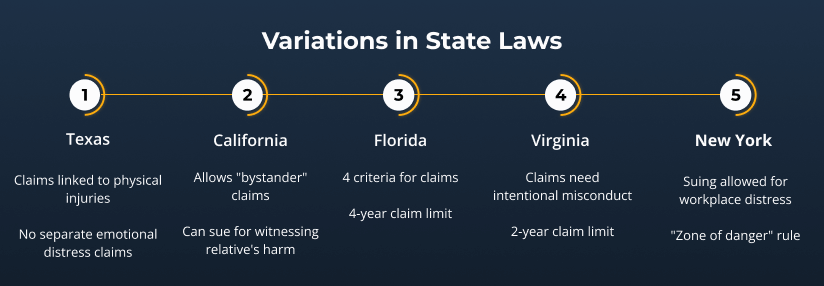
The question has a clear answer – yes. But, you can’t file a separate suing for emotional distress. Instead, it’s wrapped into personal injury claims as non-economic damages. For a valid emotional distress claim in Texas, you usually need a physical injury that’s medically verifiable. So, emotional distress claims often go hand-in-hand with tangible personal injury cases.
California recognizes “bystander” claims, allowing individuals to sue for loss of enjoyment of life if they’ve seen a close family member get harmed due to someone else’s negligence, even without any personal physical injury.
Under Florida law, to state a cause of action for intentional infliction of emotional distress, a complaint must allege 4 elements:
Florida law emphasizes the outrageousness of the conduct rather than the victim’s response. The state’s courts often shy away from suing for loss of enjoyment of life claims stemming from workplace issues. So typical co-worker harassment might not meet the “outrageous” benchmark, no matter how blatant.
Also, the statute of limitations on emotional distress in Florida is 4 years, which is twice longer than in other states.
In Virginia, seeking damages for emotional distress comes with tighter constraints than in many other states. For emotional distress claims in Virginia, mere symptoms like anxiety, depression, or sleeplessness won’t suffice unless accompanied by a physical injury or evidence of intentional misconduct. The state sets a high bar for these claims, demanding physical harm or proof of deliberate or reckless behavior.
Virginia courts are often skeptical of these claims, wary of potential exaggerations or fabrications. The behavior in question must exceed all bounds of decency, as illustrated by Virginia’s case law.
So, what is the statute of limitations on emotional distress in Virginia? Emotional distress claims fall under the two-year limit set for personal injuries.
In the state of New York, if you face a workplace injury due to the negligence of your employer or coworker, your recourse is limited to suing for emotional distress at work. But, if a third party, outside of your employer or coworker, is responsible, you have the right to take legal action against them.
Can you sue the government for emotional distress? Yes, New York has waived its sovereign immunity, but victims must adhere to specific guidelines. If you face discrimination or are a victim of police misconduct, such as false arrest or excessive force, you must file a “notice of claim” to seek recovery.
New York is one of the few states that apply a “zone of danger” rule. So plaintiffs need to prove a risk of serious injury or death in the incident that harmed their immediate relative.
The time frame to file an emotional distress claim differs across states and doesn’t always align with the usual two-year period. Here are examples of state law differences:
1 year
Kentucky, Louisiana, Tennessee
3 years
Arkansas, Colorado (for auto accidents), Maryland, Massachusetts, Michigan, Mississippi, Montana, New York, North Carolina, Washington, Wisconsin
4 years
Nebraska, Utah, Wyoming
5 years
Missouri
6 years
Maine, North Dakota
Always double-check with local regulations, but this gives you a snapshot!
In a landmark emotional distress case, Dr. Michael V. Fitzgibbons won a $5.7 million verdict against his former employer, IHHI. The CEO’s intentionally harmful actions and threats led to Dr. Fitzgibbons’ severe emotional turmoil. While the trial court initially sided with IHHI, the Appellate Court reinstated the jury’s decision, emphasizing that employers can be held liable for employees’ actions within their job scope. This case highlights how skillfully navigating the legal system can bring wrongdoers to account for emotional harm.
Considering suing for emotional distress? It’s not just about the pain but building a solid case. If you aim to sue for emotional damage, team up with a mental anguish attorneys or contact us to navigate the legal intricacies.
Your injury receives a grade from 1 to 5. Using this grade, the court multiplies your economic damages to calculate your potential recovery.
On average, up to $10,000, but some PTSD cases involve up to $100,000.
There’s no fixed cap, but in some cases, it is possible to recover $500,000 and more.
They include depression, anxiety, isolation, weight problems, and physical symptoms linked to emotional turmoil.










